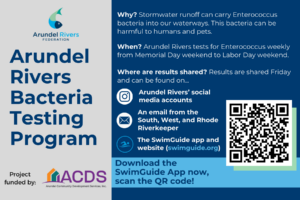July 17, 2024
July Riverkeeper Report
I think we are all probably thinking the same thing when reflecting on the last month: hot, hot, hot!!! Shout out to our water monitoring crew who has been out every week despite the heat advisories and 100+ temperatures we’ve been experiencing the past few weeks.
Temperatures have ranged from 77 degrees in our deeper sites near the bay to 88 degrees in shallow creeks. This is a 30 degree increase from our first sampling day in April and a 5 degree increase from temperatures this time last year. On the other hand, salinities this year remain lower compared to 2023. Salinity levels are currently measuring about 8-9ppt, compared to this time last year where we saw an average around 12-13ppt. Perhaps this is why we still haven’t seen the usual swarm of jellyfish that invade our rivers by now? We have seen no deadzones (or no oxygen events) in the month of July so far, but we have recorded low bottom oxygen in Glebe Creek, Aberdeen Creek, Gingerville Creek, and near the Riva bridge on the South River. Our site near Riva Bridge did however receive the best clarity reading for the month so far with about 2.8 feet! The worst clarity reading of the month was taken in Lerch Creek on the West River, with a reading of just under a foot.
We are more than halfway through our bacteria monitoring program for the 2024 season. The program now has 28 sites, an increase from 21 in 2024. In addition to the new parameters being collected this year, including tidal, temperature, and rainfall data, we are also enhancing our bilingual education and outreach on the program. Check out these new info cards which will be handed out at our community outreach and tabling events. We are also working on bi-lingual signage for communities that are interested in posting educational material like this at their community beach or pier.

Your South, West, and Rhode Riverkeeper
Elle Bassett
